Introduction
During the winter, outdoor walking tours face challenges due to weather conditions. Despite canceling several tours, historical research at the Wilkes Street Cemetery Complex has continued. A team of volunteers has pursued the exploration of the site’s history, ensuring research progress continues.
Ground Penetrating Radar (GPR) and Mark Ludlow’s Surveying Efforts
A critical effort in this ongoing research is using Ground Penetrating Radar (GPR) to locate long-forgotten graves. GPR is a non-intrusive examination tool that employs radar pulses for subsurface imaging, allowing researchers to detect underground features such as concrete, asphalt, metals, pipes, cables, and masonry without disruptive excavation. This technology is particularly crucial in cemetery research, as it identifies gravesites while preserving the site’s historical integrity and advancing our understanding of the past.
Mark Ludlow, a Registered Professional Archaeologist and owner of M3 Archaeology LLC has been at the forefront of this effort. He has dedicated significant time to surveying four plots within the cemetery complex using GPR, yielding unexpected discoveries that have shed new light on the lives and legacies of those buried there.
The Adam/Irwin Family Plot
In preparation for a March 16, 2024, grave marking event organized by the Fairfax Resolves Chapter and the George Washington Chapter of the Sons of the Virginia Society Sons of the American Revolution, Ludlow scanned three plots in the Presbyterian Cemetery where the honored individuals are buried.
Robert Adam (1731-1789), a prominent Alexandria merchant who served on the Alexandria and Fairfax Committees of Safety and signed the Fairfax Resolves in 1774, is believed to be buried in the Adam/Irwin family plot. On February 14, Ground Penetrating Radar (GPR) was employed to ascertain the number of burials in two burial plots, 41:14 (whole plot) and 41:13 (east half plot), within The Presbyterian Cemetery (established 1809), as depicted by Pippenger Vol. 1. (1998: 91) and in Figure 1 below. Ludlow’s GPR survey revealed fourteen unmarked grave-like anomalies or graves in burial plot 41:14 (whole plot), with seven on each side of the family obelisk.
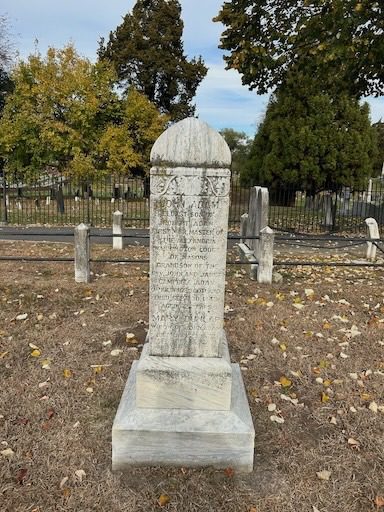
Ludlow’s GPR survey revealed fourteen unmarked grave-like anomalies or graves in burial plot 41:14 (whole plot), with seven on each side of the family obelisk.
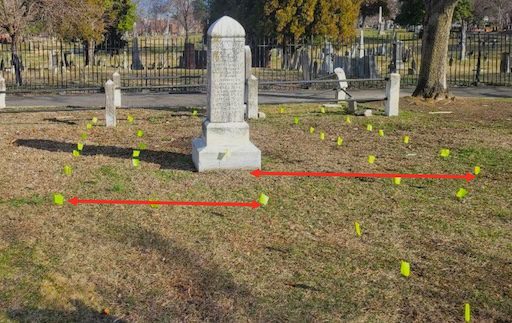
The adjacent ADAM plot 41:13 (east half plot), the GPR survey discovered three unmarked grave-like anomalies and four large standing gravestones. It confirmed the burials associated with each standing tombstone and a single burial below ground associated with an extant low plaque box tomb.

For more information about Robert Adam, please visit the following link [Robert Adam: Masonic Leader and Fairfax Resolves Signer in Alexandria].
John Dundas
John Dundas (1759-1813), who served in the Philadelphia City Militia during the American Revolution and later rose to Lieutenant, is considered buried in the Dundas plot. The plot contains a worn obelisk and a low, flat plaque tomb box dedicated to the memory of Newton and Nancy Moore Keene and their children. Nancy Moore Keene, the eldest daughter of John and Agnes Dundas, is believed to be buried in this plot alongside her husband and children. It is important to note that this Keene family is unrelated to James Keene, the firefighter mentioned later in the article.
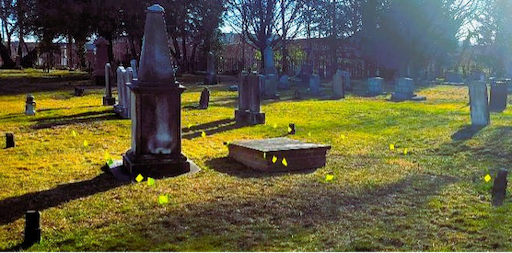
Ground Penetrating Radar (GPR) analysis revealed that all detected grave-like anomalies (graves) are oriented in the traditional west-east direction. Interestingly, the low, flat plaque tomb box is placed in a south-north orientation, likely due to the pre-existing obelisk limiting alternative placement options.
Further GPR imaging of the plaque tomb box confirmed the absence of any burial or inhumation within its above-ground portion. This suggests that the box serves an informational purpose, potentially providing details about the unmarked west-east-oriented graves throughout the plot.
Photograph by Mark Michael Ludlow RPA, February 27, 2024.
GPR imaging confirmed that there is no burial within the above-ground portion of the box, suggesting it serves an informational purpose. Pippenger’s records do not confirm an inscription or marker for John Dundas, but his burial date is sourced from an Alexandria Gazette newspaper reference.
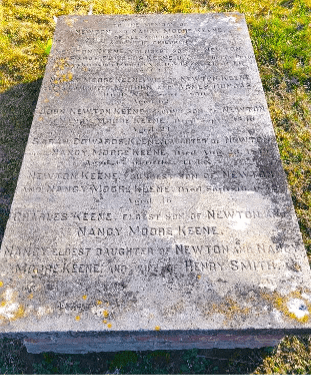
The box tomb memorializes the Dundas and Keene family members interred within the plot, providing a lasting tribute to their lives and familial connections.
Photograph by Mark Michael Ludlow RPA, February 27, 2024.
The following is the inscription engraved on the flat plaque box tomb situated within the plot.
| To the memory of NEWTON and NANCY MOORE KEENE of Alexandria, Va. and their children NEWTON KEENE, youngest son of NEWTON and SARAH EDWARDS KEENE, born at Cherry Point Northumberland Co., Va., Died Sept. 21, 1841 aged 74 years NANCY MOORE KEENE, wife of NEWTON KEENE eldest daughter of JOHN and AGNES DUNDAS died NY, Sept. 9, 1850 aged 52 JOHN NEWTON KEENE, second son of NEWTON and NANCY MOORE KEENE, Died Sept. 1836 aged 24 SARAH EDWARDS KEENE, daughter of NEWTON and NANCY MOORE KEENE, Died Augs. 23, 1849 aged 17 months, 11 days NEWTON KEENE, youngest son of NEWTON and NANCY MOORE KEENE, Died Aept. 16, 1842 aged 16 CHARLES KEENE, Eldest son of NEWTON and NANCY MOORE KEENE NANCY, eldest daughter of NEWTON and NANCY MOORE KEEN, and wife of HENRY SMITH |
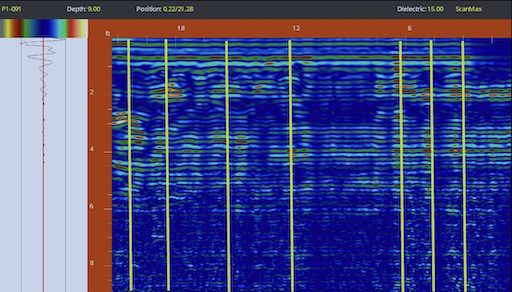
The GPR data provides valuable insights into the subsurface layout of the burial plot, allowing for the identification and mapping of graves that visible surface markers may not mark. This non-invasive technique contributes to documenting and understanding the cemetery’s historical and archaeological context.
Captain David Black
A surprising discovery was the location of Captain David Black’s (1762-1831) grave. Black, a distinguished figure in Alexandria known for his maritime skills and civic dedication, served as a drummer boy in the Revolutionary War. The family plot has one large, mostly illegible gravestone and four small stones marking some burials. Pippenger’s records list nine persons buried in the plot, while GPR detected seven additional unmarked graves. The order of the four extant tombstones appears to be chronological. Ludlow could identify Captain Black’s resting spot using Pippenger’s records and GPR imaging.
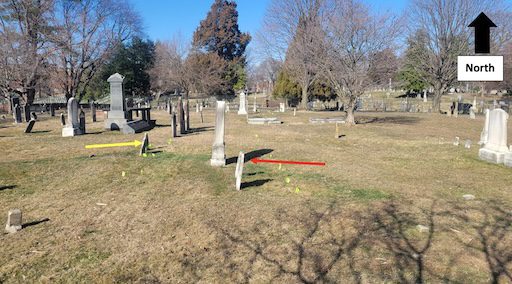
The Friendship Fire Company Plot
Perhaps the most significant find was the long-lost grave of Charles Glasscock in the Methodist Protestant Cemetery. Glasscock was a firefighter with the Friendship Fire Company who died on Wednesday morning, June 30, 1852, from injuries sustained when the company’s fire engine ran him over on Monday evening, June 28, 1852. The fire engine that tragically ran over Glasscock in 1852 was a suction pump acquired from John Rogers in Baltimore the previous year. Operating this pump required a workforce of at least 20 individuals, and its nozzle was uniquely designed to propel water as far as 160 feet.
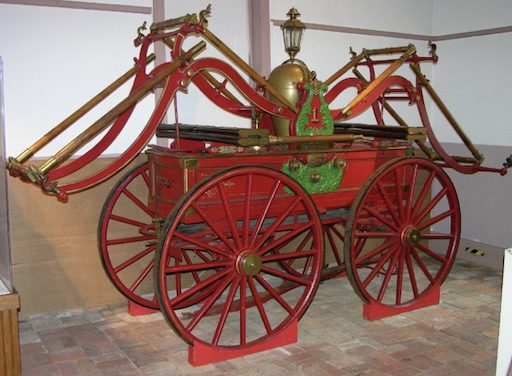
Initially, it was believed that James Keene, a firefighter killed in the November 17, 1855 fire at the Dowell China Shop, was buried in the plot. Keene’s death, along with six others that night, led to the establishment of an obelisk at Ivy Hill Cemetery, where the Alexandria Fire Department holds an annual memorial ceremony.

The red oval highlights Burial Plot 60 (Plot E60 North Half), a half plot measuring approximately 7′ x 12′, purchased and owned by the “Friend Ship Fire Co.” A Ground Penetrating Radar (GPR) survey conducted by Mark Michael Ludlow RPA revealed a single grave-like anomaly (a burial) in that plot. The Burial Book of the Methodist Protestant Church Cemetery (1833) records this Burial Half Plot on June 30, 1852.
Image modified by Mark Michael Ludlow RPA, Registered Professional Archaeologist, Registrant ID #16263, February 18, 2024. Map source: Amy Babcock, AKA Mrs. Bee. Map imaged from archives at The Kate Waller Barrett Branch, Local History/Special Collections, Alexandria Library, 717 Queen Street Alexandria, Virginia, 22314.
During a discussion between Catherine Weinraub, Mark Ludlow, and David Heiby about the grave, they initially agreed that it was likely James Keene who was buried there. However, Weinraub, who has extensive knowledge of Alexandria’s fire history through her work at the Friendship Fire House, had a sudden realization. She remembered the 1852 death of Charles Glasscock, which prompted her to consult historical records with which she was familiar. This corrected the initial assumption, as Weinraub presented her facts about Glasscock’s death to Ludlow and Heiby.
Acting on Weinraub’s information, Mark Ludlow conducted further research. He discovered the deed book of the cemetery in the Local History/Special Collections at the Kate Waller Barrett Branch of the Alexandria Library. The deed book records that Friendship Fire acquired Plot 60 on the day Glasscock died, June 30, 1852. No other burials are in the plot, and Keene’s exact burial location remains unknown. Ludlow also conducted a GPR survey, which verified the presence of a lone grave, confirming Weinraub’s findings. The photograph of the recording stub from the cemetery’s deed book clearly shows the entry dated June 30, 1852, indicating that the Friendship Fire Company owned the North Half of Burial Lot 60, further confirming Weinraub’s findings and Ludlow’s research.
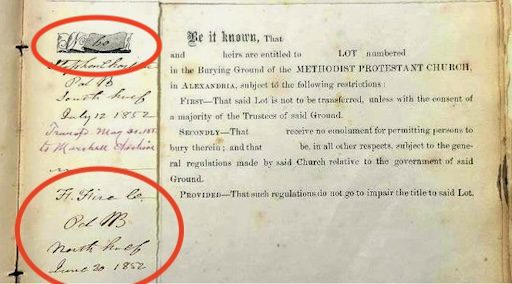
The right side of the image displays a blank deed/purchase receipt from the next page in the sale/purchase/deed book. These receipts were typically torn out and provided as proof of initial purchase/ownership, although not all burial lot purchasers received or retained these tear-out paper receipts.
The larger red oval on the left side encompasses the receipt tab, indicating that the ownership of the North Side of Burial Lot 60 was transferred from the original and previous purchaser to the Fr. Fire. Co. on June 30, 1852. No subsequent owner for the North Half of Burial Lot E60 was found in the Methodist Protestant Cemetery’s existing plot sales record book (1833).
Source: Local History/Special Collections, Kate Waller Barrett Branch, Alexandria Library, Boxes 242 (multiple boxes). Image modified by Mark Michael Ludlow RPA, February 20, 2024.
The Significance of Charles Glasscock’s Grave Discovery
The discovery of Charles Glasscock’s grave is a significant milestone in Alexandria’s history, as it sheds light on the sacrifices made by early firefighters and the importance of preserving their legacy. Catherine Weinraub’s expertise and intimate knowledge of Alexandria’s fire history were instrumental in correcting the long-standing historical misconception that James Keene was buried in the Friendship Fire plot. Her “ah-ha” moment, triggered by her recollection of Glasscock’s death, set in motion the research that ultimately led to the identification of the grave.
Mark Ludlow’s subsequent discovery of the deed book and his GPR survey provided crucial evidence supporting Weinraub’s findings, demonstrating the collaborative nature of historical research and the importance of combining various sources of information to uncover the truth about the past. The radargram image 75C, taken by Ludlow on February 17, 2024, clearly shows the presence of a single distinct burial in the North Half of Burial Plot E60, owned by the Friendship Fire Company, as indicated in Figures 1 and 2.
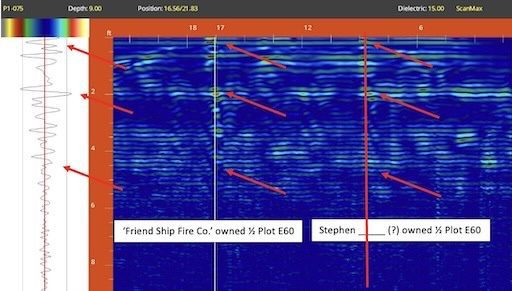
The ground disturbance starts near the surface and proceeds to a depth of approximately four and three-quarters feet (4 ¾’), as shown by the depth scale on the right side in the vertical red bar. The linear scale across the surface is represented by the horizontal red bar. At a depth of about two feet (2′), greater resistance is shown, suggesting the top of the coffin or human remains.
The red vertical line marks the position of the single distinct burial in the South Half of Burial Plot E60. Figure 2 shows that Stephen (Illegible)? owns this South Half (1/2) of Plot E60.
Radargram image by Mark Michael Ludlow RPA, February 17, 2024.
Collaboration and Dedication
The project’s success in researching the Adam/Irwin, Dundas, and Black plots can be attributed to the collaborative efforts of passionate individuals. The project benefited greatly from the enthusiasm and support of volunteers Sue Ellen Morgan, an Old Presbyterian Meeting House and Alexandria Historical Society member, along with Jonathan and Maria Davis, who volunteer at the Presbyterian Cemetery.
Also involved were David Heiby, Superintendent of The Presbyterian Cemetery, owner of Gravestone Stories, and a public historian who contributes to the preservation of Alexandria’s cemeteries and burial grounds, and Catherine Weinraub, the historian for The Friendship Fire Company, Ivy Hill Cemetery, and Beth-El Congregation. Heiby and Ludlow are current board members at the Alexandria Historical Society, while Weinraub is a past board member and served as their secretary.
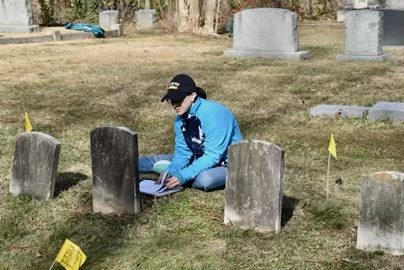
Mark Michael Ludlow, RPA, is a noted ornithologist, wildlife expert, Army Airborne Ranger, professional archaeologist, and author of dozens of birding articles. He has lived in the area for over 30 years. Ludlow holds a B.A. in Anthropology from Drew University and an M.A. with Merit in Archaeology from The University of Leicester, Leicestershire, England. He is a registered professional archaeologist (RPA) and an AMDA-certified metal detectorist.
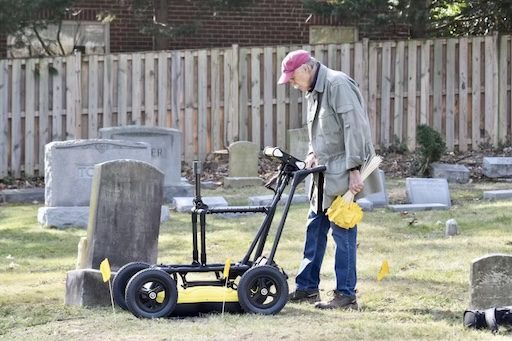
Ludlow has experience in Eastern Woodlands archaeology, historical archaeology, the archaeology of historic standing buildings, and Pre-Columbian Caribbean ornitho-archaeology. Additionally, he is a past member of the Alexandria Archaeological Commission, a current member of the Alexandria Historical Society, and the owner-operator of M3 Archaeology LLC, located in Alexandria, VA.
Preserving and Celebrating Alexandria’s Rich Historical Tapestry
These discoveries highlight the importance of historical research, collaboration, and the application of modern technologies in uncovering and preserving the legacies of significant figures in American history. The upcoming grave-marking event will serve as a tribute to the contributions of Robert Adam, John Dundas, and Captain David Black, while the discovery of Charles Glasscock’s grave adds a new dimension to Alexandria’s rich historical tapestry.
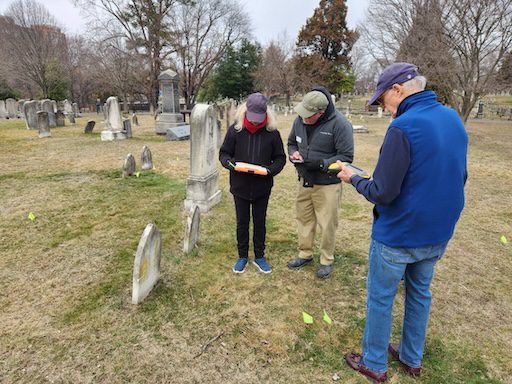
The collaborative efforts of professionals and volunteers involved in this project have brought these stories to light. The passion and dedication of individuals like Catherine Weinraub, Mark Ludlow, David Heiby, Sue Ellen Morgan, Jonathan and Maria Davis, and many others have made it possible to uncover long-forgotten graves and piece together the narratives of those who lie beneath.
As we continue to explore and document the history buried within Alexandria’s cemeteries, we not only honor the lives of those who came before us but also enrich our understanding of the city’s past. By engaging the community in this process of discovery and preservation, we ensure that these individuals’ legacies will endure for generations to come.
The tireless efforts of the professionals and volunteers involved in this project serve as a testament to the power of collaboration and the importance of preserving our shared history. As we move forward, let us continue to work together to uncover the untold stories that lie waiting to be discovered and, in doing so, celebrate the rich historical tapestry that makes Alexandria such a unique and fascinating place.
Sources of Information
Pippenger, W. E. (1992). Tombstone Inscriptions of Alexandria, Virginia: Volume 1. Family Line Publications.
Pippenger, W. E. (2008). Tombstone Inscriptions of Alexandria, Virginia: Volume 2. Heritage Book, Inc.
Dahmann, D. C. (2002). The Roster of Historic Congregational Members of the Old Presbyterian Meeting House.
Ludlow, M. (2024). Ground Penetrating Radar (GPR) Survey Short Report Regarding ROBERT ADAM (1731-1843) Signer of The Fairfax Resolves, Burial Plot 41:14, First Presbyterian Church Cemetery (1809). Unpublished report.
Ludlow, M. (2024). Ground Penetrating Radar (GPR) Survey Short Report Regarding Capt. (Ship Captain) DAVID BLACK (1762-1831) American Revolutionary War Patriot, Burial Plot 41:11, First Presbyterian Church Cemetery (1809). Unpublished report.
Ludlow, M. (2024). Ground Penetrating Radar (GPR) Survey Short Report Regarding JOHN DUNDAS (Died 29 August 1813), American Revolutionary War Patriot, Burial Plot 42:69, First Presbyterian Church Cemetery (1809). Unpublished report.
Ludlow, M. (2024). Ground Penetrating Radar (GPR) Survey Short Report Regarding CHARLES GLASSCOCK (Died 30 June 1852), Burial Plot E:60, Methodist Protestant Cemetery (1833). Unpublished report.
Weinraub, C. (2023). Friendship Fire Company 250th Anniversary 1774 – 2024 Alexandria, Virginia. Friendship Veterans Fire Engine Association.
Friendship Firehouse Museum. (n.d.). Firehouse information. Retrieved from https://www.friendshipfirehouse.net/